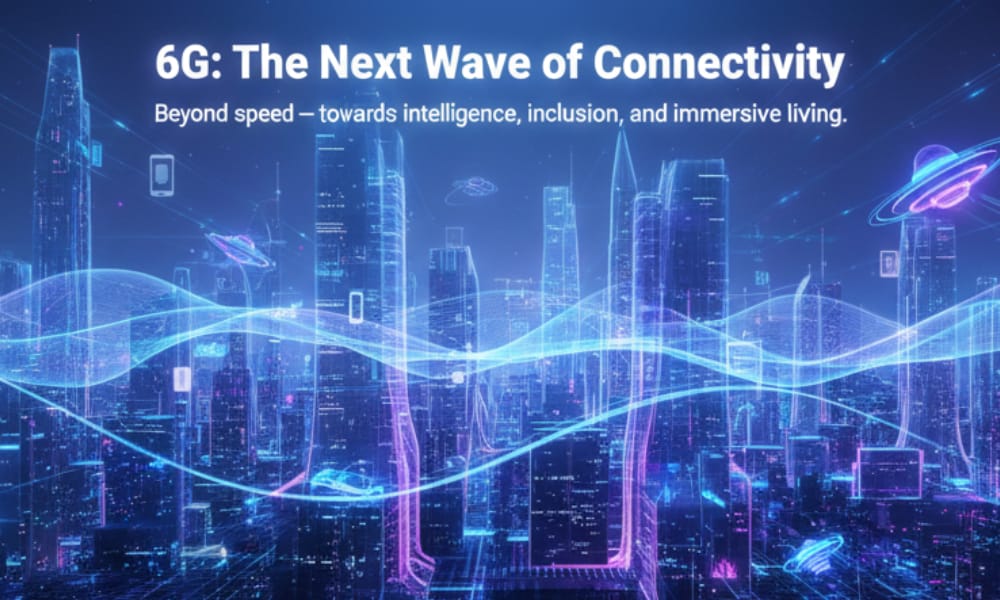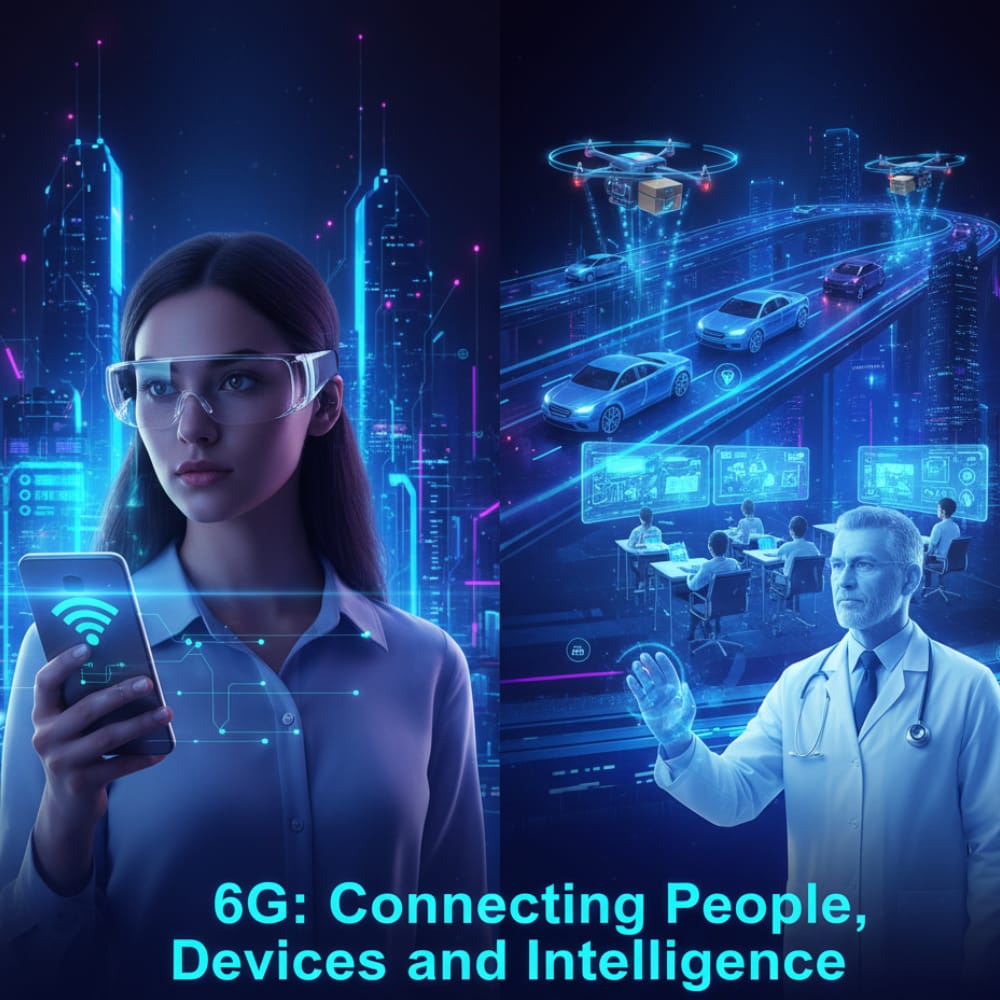6G and the Next Wave of Network: Beyond Speed
For a long time, the advancement of mobile systems has been characterized by one word, speed.
From 2G’s humble calls and texts to 5G’s lightning-fast speed, each update has guaranteed quicker downloads, smoother video calls, and more associated devices. But as the world plans for 6G, the discussion is moving from speed to experience.
6G isn’t just about making your web quicker. It’s almost changing how we live, work, and interface, both physically and digitally. Let’s investigate what this another jump in the network truly implies, and why it’s so much more than just another “G.”

What Is 6G, Really?
6G (sixth generation mobile network) is the next advancement of wireless connection, which is expected to roll out commercially around 2030. But behind that number lies a radical reconsidering of how we communicate.
Where 5G centered on high data speeds and low latency (the delay between sending and getting information), 6G will center on intelligent connectivity, joining AI, detecting, and ultra-reliable communication to make gadgets mindful of their surroundings.
It’s like giving your phone, your car, and indeed your fridge the capacity to think, sense, and react in real-time.
From Quick to Smart: What Makes 6G Different
- Beyond Speed, Towards Intelligence
6G points to be more than just a thruway for information. It’s being built to combine communication with computation and sensing.
That implies your gadget won’t just interface to the web, it will get its context.
For instance, a 6G-powered wearable might sense your heart rate, environment, and enthusiastic tone from your voice, then alter your playlist or lighting to calm you down, all immediately and without requiring you to “ask.”
- Latency So Low It’s Nearly Zero
5G as of now decreased latency to almost 1 millisecond. 6G might bring it down to microseconds.
That’s about immediate reaction time, pivotal for things like remote surgery, self-driving vehicles, and augmented-reality classrooms.
- Device Connectivity
The Internet of Things (IoT) is about to explode, as smart homes and wearables will be the next big thing and factories will run on sensors.
6G will support 10 times more than 5G, making communication better between billions of gadgets.
- Terahertz Spectrum: The Mystery Ingredient
6G will work on terahertz (THz) frequencies, which are much higher than 5G’s.
This permits unfathomable speeds, supposedly up to 1 Tbps (terabit per second), but it moreover implies unused framework challenges, since higher frequencies travel shorter distances and require more precise network coverage.
6G’s Effect on Ordinary Life
It’s easy to expect that quicker internet just implies quicker Netflix. But 6G’s potential goes much more profound. Here’s how it might alter your day by day life:
- Hyper-Real Virtual Worlds
The so-called “metaverse” which we’ve only started to see seems to finally become real.
With 6G’s almost zero latency, people will get to explore immersive virtual experiences, which are made for gaming, learning, shopping, and socializing.
- Smart Cities and Homes
6G will change the system of smart cities, where everything, traffic lights, public transport, healthcare, communicates efficiently.
Your home will also become more natural: appliances that understand your needs, lighting that responds to mood, and energy systems that adjust power based on your demand.
- Holographic Mode of Communication
Video calls will be converted into 3D holographic conversations.
Speed of 6G can make life-sized holograms for meetings, helping remote work, education, and worldwide collaboration feel like human again.
- Remote Medicine and Surgery
Doctors might perform surgeries remotely with mechanical accuracy, thanks to 6G’s ultra-low latency.
Healthcare checking will also become predictive, devices could identify sicknesses before symptoms even appear, sending alarms right away to specialists or family members.
- Sustainable Connectivity
6G is being planned with energy efficiency in mind.
AI-powered systems will optimize power utilisation, switching gadgets or organising sections on and off automatically to spare energy, a vital step toward reducing tech’s natural footprint.
The Role of AI in 6G
If 5G was about connecting devices, 6G is about connecting intelligence.
AI won’t just run on top of 6G, it will be built into the network itself.
This means networks that self-learn, self-heal, and self-optimize. For instance:
Detecting and fixing signal issues automatically.
Predicting data surges before they happen.
Adjusting performance based on what clients are doing, streaming, gaming, or working.
In brief, 6G will think for itself, creating a more steady, proficient, and human-like digital environment.
Challenges Ahead
While 6G sounds progressive, it’s not without hurdles.
- Infrastructure Overhaul
New frequencies like THz require completely new hardware, antennas, and base stations. Setting this up globally will take time, investment, and collaboration over nations.
- Power and Cost
Ultra-fast information implies ultra-high energy demand. Guaranteeing that 6G remains maintainable and reasonable will be a challenge for engineers and governments.
- Privacy and Security
When each device is intelligent and context-aware, it will collect gigantic sums of personal information. Securing this information, particularly in a world where even feelings can be detected, will be one of the ethical debates of the decade.
- Bridging the Digital Divide
As innovation propels, there’s a hazard that rural and underdeveloped zones may be left behind.
6G must aim not only for development, but incorporation, making sure connectivity engages everybody, not just the privileged few.

The Global Race for 6G
Countries like South Korea, Japan, China, the U.S., and Finland have as of now started 6G trials and research.
India, as well, is venturing into the race, with the government’s Bharat 6G Vision 2030 centering on homegrown technologies and rural digital inclusion.
This worldwide collaboration will characterize who leads the following wave of the digital economy, since 6G isn’t just a network update; it’s a geopolitical advantage.
What It Means for the Future
6G will blur the boundaries between physical and advanced worlds.
Imagine children learning from holographic instructors in their nearby language, farmers utilizing AI-powered drones associated through 6G to monitor crops, or disaster zones where instant network spares live.
That’s the guarantee, and duty, of the following era of connectivity.
Conclusion
Conclusion
6G is not just another number in the tech timeline, it’s the establishment of a smarter, more connected, and more compassionate digital world.
It’s about systems that understand, and innovation that works behind to make our lives better.
Yes, it will be faster, but what really makes 6G extraordinary is how it aims to bring information, sympathy, and consideration into our digital future.
In conclusion, the story of 6G isn’t just about technology.
It’s about making a world where networking means more than just being online, it means being understood, backed, and enabled.








